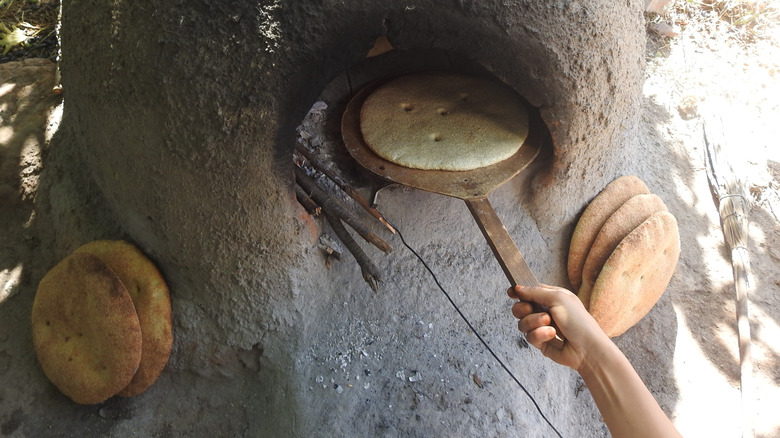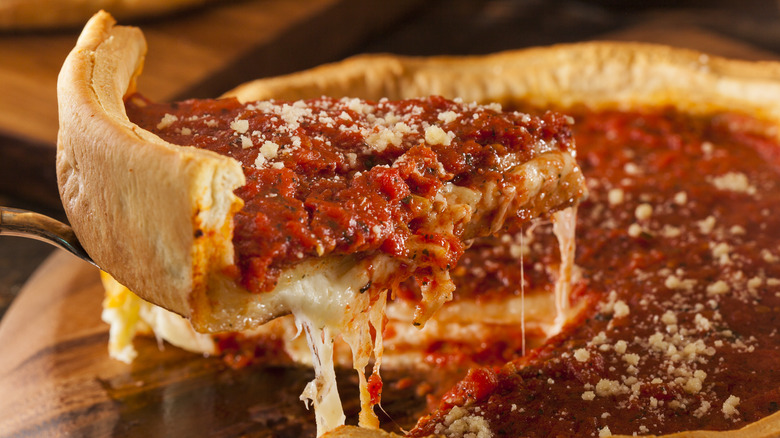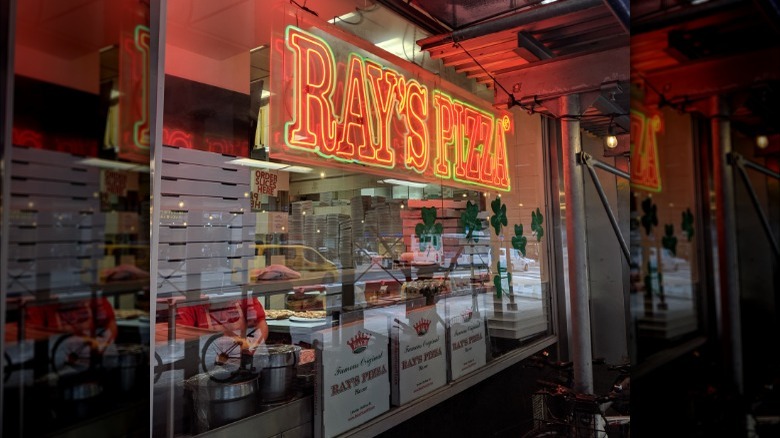What Everyone Gets Wrong About The History Of Pizza
If you're like 93% of Americans, you've eaten at least one slice of pizza in the last month (via South Florida Reporter). Pizza has become a quintessential food in the American diet, with regional variations popping up across the country as locals put their own twist on the dish. Its popularity is no surprise since it's a filling, affordable, and easy-to-eat meal that can be tailored to just about any taste.
But do you know which country invented the popular cheesy dish? Do you know the source of pepperoni, America's favorite pizza topping, according to a survey conducted by YouGovAmerica? If you answered Italy to either of those questions, you're wrong. But the myths and half-truths surrounding one of the world's favorite foods have persisted for decades, so don't feel bad if you've fallen for some of them yourself. Here are some of the most common facts about the history of pizza that almost everyone gets wrong.
Pizza technically wasn't invented by Italians
The origin of pizza is surprisingly murky. The now global dish has its roots in the flatbreads eaten across North Africa and the Middle East for thousands of years. Among the many versions, Persian soldiers would fry the dough on their shields in 500 B.C. and top it with cheese and dates. Similarly, Ancient Greeks and Egyptians were baking flatbreads topped with herbs, cheese, and other toppings still found on pizza today around the same time period. Already centuries ago, these proto-pizzas were so widespread for the same reason pizza is popular today: It's a convenient, low-cost, satisfying meal that you can eat on the go.
The tomato-based sauce that now seems to be an essential component wasn't introduced until tomatoes arrived in Naples, by way of Peru, in the 1500s. The coming together of tomatoes and cheesy flatbread in Naples is the reason Italy gets the credit for bringing pizza to the world. But, in reality, pizza is a fusion of global culinary influences spanning at least three continents.
Pepperoni pizza's popularity isn't rooted in Italy
It took three continents to invent the cheese and tomato-topped pizza we know and love today, but it took a fourth to invent the pepperoni pizza. Despite the Italian-sounding name, pepperoni isn't actually from Italy. In fact, "pepperoni" isn't even an Italian word. "Peperoni" is the Italian word for bell pepper, but with a second "p," it doesn't mean anything except that you spelled it incorrectly.
Pepperoni is an American word that refers to a style of dried sausage that was created in the United States sometime around World War I and didn't appear on pizza until after World War II. While it's become one of the most iconic toppings in the United States, you'd be hard-pressed to find a pepperoni pizza in Italy unless you're at a restaurant that offers American-style pies. Even then, you'll probably need to ask for a Diavola, or "Devil's" pizza, which is what Italians have come to call the American staple.
Queen Margherita probably never ate Margherita pizza
Named after Queen Margherita, a Margherita pizza features a combination of tomato, cheese, and basil. Legend has it that the Italian queen smelled the delicious aroma of Raffaele Esposito's pizzeria in Naples in 1889. The smell was so tantalizing, she invited Esposito to the palace to cook pizza for herself and her husband. Esposito made three different versions, including one with tomato, cheese, and basil to represent the colors of the Italian flag. The patriotic pizza was the Queen's favorite so Esposito named it Margherita pizza in her honor.
The legend endured for so long, in part, because Esposito had a letter from the Queen in his pizzeria, declaring the red, white, and green pizza to be her favorite. But, historians now seriously doubt that the letter really came from the Queen or anyone in the palace.
Not only is the letter a likely forgery, but pizza was a street food then just as it is today. Royals would rarely stoop to eat common food. If they did, there would have definitely been plenty of news coverage about the event — something that's lacking in historical records of the time period. If that isn't reason enough to doubt Esposito's claims to royal fame, the fact that he was already calling his shop "The Queen of Italy Pizzeria" at least six years before the alleged visit should.
It wasn't until pizza left Italy that it actually became popular
Pizza was historically the food of common people in Italy, which meant it had all the glamor of a hot pocket or cup-of-noodles for modern foodies. Neapolitans of the 19th century and earlier ate pizza because they needed something quick, easy, and affordable — not because it was their preferred dish. At the time, pizza still hadn't achieved its modern form. Instead of the soft, foldable slice with melted cheese and seasoned tomato sauce we know, the pizza of working-class Naples was a hard disc of dough topped with nearly-raw garlic, tomato, and herbs. Nutritious? Sure. Tasty? Debatable.
It wasn't until Italians began immigrating to the U.S. around the turn of the century that pizza started to build up a reputation as something you'd actually want to eat. Italian immigrants brought the humble dish with them and began adapting their own recipes. Americans who'd grown fond of pizzas visited Italy thinking they would find the dish everywhere they went. Instead, it was still primarily a regional food from Naples.
The demand from tourists turned pizza-making into a lucrative business, so Italians all over the country started making it and creating regional adaptations of their own. Over time, it evolved from a barely-edible bread disc into a beloved delicacy both in Italy and around the globe.
World War II vets aren't responsible for bringing pizza to the US
This myth gets almost as much airtime as the tale that Queen Margherita gave her seal of approval to her namesake pizza. The story goes that American soldiers in Italy during World War II developed a love for pizza and brought it home. The main problem with this story is that Italian immigrants were already in the U.S. making pizza long before World War II. While it was still considered an ethnic cuisine, it was slowly gaining recognition in places with large Italian populations, like New York and Chicago.
Another problem with the story is that pizza was still a relatively under-the-radar regional dish from Naples at the time. During World War II, few American soldiers were sent to Italy and even fewer to Naples. Even if those soldiers developed a taste for pizza while they were there, there simply weren't enough of them to spark a nationwide trend on the scale that pizza achieved in the post-war era.
Instead, the reason for the explosion in popularity is likely the gas oven. Unlike traditional wood- or coal-fired ovens, gas ovens were cheap and easy to operate, which made it possible to cook more pizzas and sell them at a lower price. Now that pizzerias were more cost-efficient, they began opening franchise locations stretching beyond Italian neighborhoods.
[Featured image by Nick Parrino via Library of Congress | Cropped and scaled | Public Domain]
Hawaiian pizza isn't from Hawaii
Despite its name, Hawaiian pizza was not actually invented in the island state or even by a Hawaiian. It was a Greek-Canadian man by the name of Sam Panopoulos who first put canned pineapple chunks on top of a pizza in London, Canada in 1962. When Panopoulos immigrated to Canada in the 1950s, pizza was still a relatively unknown dish in the country. When it slowly started popping up in Canadian cities, diners really only had three toppings to choose from: pepperoni, bacon, or mushrooms.
Panopoulos was determined to inject more variety into the Canadian pizza scene so he started trying different combinations at home, using anything he could think of to see what worked. The inspiration to try pineapple with ham came from the unique pairing of sweet and savory in Chinese cuisine. The Greek-Canadian dubbed the Chinese-inspired dish Hawaiian pizza because the brand of the canned pineapple chunks was Hawaiian.
Hawaiian pizza isn't even the most divisive pizza ever invented
If you thought pineapple was the most polarizing topping in the pizza world, you haven't tasted pizza in Sweden. Around the same time Panopoulos was experimenting with pineapple in his Canadian diner, Swedish pizzerias were creating tropical pizzas of their own. The "Tropicana," which can be found at most Swedish pizzerias today, features ham, pineapple, curry, and bananas. Much like Hawaiian pizza, some swear by the banana-laden pie while others still have nightmares about it.
To understand why it even exists, you need to know that Sweden really, really loves bananas. According to FruiTrop, the country consumes more bananas per capita than most other European nations. When the tropical fruit first arrived on Swedish shores in 1906, it practically became an overnight sensation. This was largely due to a successful advertising campaign that told Swedes that if they ate more bananas, the increased consumption would drive down prices, making them more affordable to more Swedes. In other words, eating bananas became a patriotic duty.
The ad campaigns for bananas also turned experimenting with the ingredient into a lucrative side hustle. Advertisements offered housewives attractive pay in exchange for creating new recipes using bananas. Between an obsession with bananas and an experimental spirit, it was only a matter of time before a Swede put banana slices on pizza.
Historically, fruit actually does belong on pizza
However you might feel about pineapple or bananas on pizza, the argument that fruit doesn't belong on pizza doesn't hold up to historical scrutiny. Those Persian soldiers frying proto-pizza flatbreads on their shields were topping them with cheese and dates, the sweet fruit from the date palm. People across the Mediterranean top their cheesy flatbreads with figs or grapes and sometimes drizzle honey on top.
The word "pizza" was used to refer to the flatbread dish as early as A.D. 997, so these fruity toppings have been enjoyed for at least as long as we've been calling the dish by its modern name. In fact, if you want to get really technical, fruit was being served on pizza before tomato sauce even came into the mix in the 1500s. And if you want to get even more technical about it, tomato is a fruit if you ask a botanist. You don't have to like fruit-topped pizzas, but they are just as valid, historically, as any strictly savory pizza.
Real Chicago-style pizza isn't the version you're picturing
When you hear "Chicago-style pizza," you're probably picturing the big deep-dish pizza that you have to eat with a fork and knife. The deep dish may have stolen the spotlight from the city's actual signature pizza, but it's not the pizza most locals consume.
According to the Chicago Tribune, the true Chicago pizza that you'll find at the majority of pizza shops in the city is a crispy thin crust version that's so thin, it's almost like a cracker with cheese and sauce on top. Often cut into a grid of small squares, this crispy thin-crust pizza is something that you definitely eat with your hands. The style originated in taverns where owners wanted easy, satisfying, salty pub fare to serve alongside beer (via Chicago Magazine). That's why the slices are lightweight and small enough that you can hold a crispy, cheesy square in one hand and a cold beer in the other.
Ike Sewell didn't actually invent deep dish pizza
The controversy around Chicago deep dish pizza doesn't end with the fact that it's not actually the city's signature style. Many credit Ike Sewell, the Texas businessman who opened Pizzeria Uno, for inventing the deep dish style pizza that Chicago ultimately became famous for. Even the Chicago Tribune gave Sewell credit for the invention in his 1990 obituary.
But Sewell was a businessman, not a cook, and he originally wanted to open a Mexican restaurant, not a pizzeria. Some people say Sewell's business partner, Italian American Ric Riccardo, deserves the credit for creating Chicago's first deep dish pizza. The debate doesn't end there, though. Adolpho Malnati Sr., a cook who used to work at Pizzeria Uno, has claimed that the pizzeria's signature deep dish was originally his idea. Debate continues to rage over whether it was Riccardo, Malnati, or a combined effort of the two that led to the deep dish pizza.
While the issue of who deserves credit for the idea is still up for debate, historians seem to agree that Sewell's contribution was little more than suggesting the pie should have more filling than the thinner-crust pizzas Chicagoans were eating at the time. That, and popularizing the dish through effective advertising (via Chicago Tribune).
The real home of the deep dish pizza is Detroit
Deep dish might not be Chicago's true signature style but that doesn't mean it doesn't have a home. The hearty pizza's real origin is about four hours east in Detroit. In the 1940s when Pizzeria Uno started serving deep dish, Gus Guerra was creating a version of his own that would go on to become Detroit's signature style pizza. The Sicilian-born immigrant wanted to give his new home a taste of Sicilian-style pizza, rather than the Neapolitan style that was the basis of most American pizzas at the time. Sicilian pizza has a thicker, spongier base more similar to focaccia than to the airy thin crust found in Naples. It's also rectangular rather than circular.
To recreate it, he used the square steel pans that Detroit's then-flourishing automobile industry was using to clean car parts in factories. It's not known why or how Guerra came up with the idea to use automotive pans. But they were perfect for the job because they were built to tolerate very high temperatures, which were the key to a perfectly crisped crust and caramelized cheese. Although it's flown under the radar for decades, Detroit-style pizza is finally starting to get recognition. The deep dish style is hearty and filling but still served in a way that allows you to pick up a slice and eat it with your hands.
New York's Original Ray's Pizza isn't the original Ray's pizza
In New York, the dizzying array of pizzerias claiming to be the original Ray's pizza has become something of an inside joke for locals. There's Ray's Pizza, Original Ray's Pizza, Famous Ray's Pizza, Famous Original Ray's Pizza, Ray Bari Pizza, Ray's New York Pizza — the list goes on, spanning dozens of locations across the boroughs.
The mess began in 1959 when Ralph Cuomo, a Sicilian immigrant, opened Ray's Pizza at 27 Prince Street. This location, which has since closed, was simply called Ray's Pizza. The pizzeria was so successful Cuomo opened a second Ray's on First Avenue, which has also since closed. In 1964, Cuomo sold that second location to Rosolino Mangano, who went on to rename it "Famous Original Ray's Pizza." He soon expanded his new pizza empire to about 25 locations, some of which are still around today. By this point, "Ray" was becoming synonymous with pizza in New York, so new pizzeria owners with no connection at all to Cuomo started opening Ray's pizzas all across the city.
After a five-year legal battle for trademark rights between Cuomo the original Ray and Mangano the famous original Ray, the two joined forces and created USA Famous Original Ray's Licensing Corp, which is slowly bringing all of New York's phony Ray's pizzas under a single franchise, one trademark infringement lawsuit at a time.












